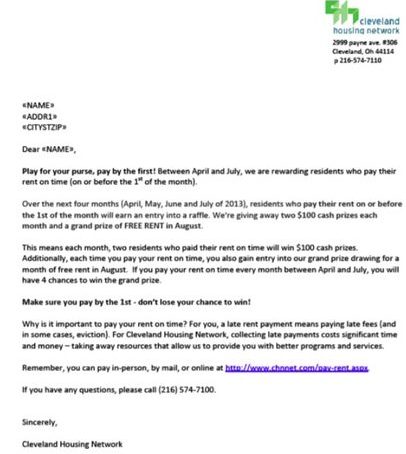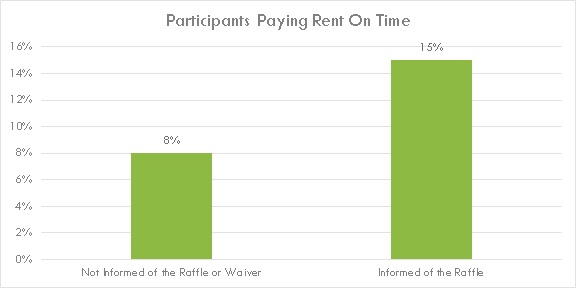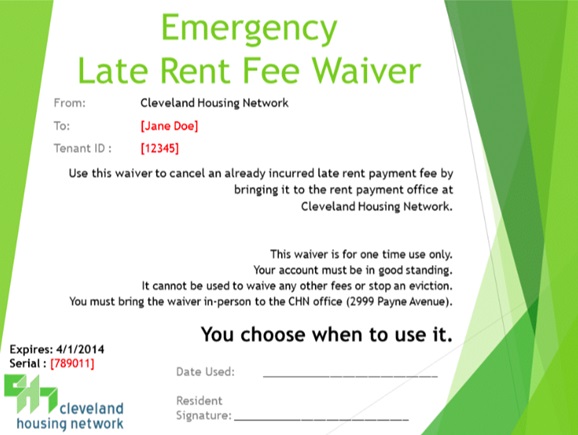
Reminders, Raffles and Rent Payments
Organization : ideas42
Project Overview
Project Summary
Residents of the Cleveland Housing Network who paid rent on time were entered into a raffle for two $100 cash prizes, with a grand prize of a free month’s rent. All residents were also sent reminders about rent five days before the deadline to increase on-time payments.
Impact
Sending renters reminders and informing them that they would be entered into a raffle if they paid on time increased the number of renters making on-time payments by 7 percentage points, from 8% to 15%.
Cost
The letters cost $1 each to mail. The raffles cost $1.50 per person entered.
Challenge
The Lease Purchase Program applies rent toward a home’s purchase price–helping low-income families become homeowners. But to be eligible, residents must pay rent on time. Despite having multiple payment options, many Cleveland Housing Network clients in the Lease Purchase Program fail to pay their rent on time, resulting in fees, potential eviction and missed opportunities for purchasing their homes.
Design
The Cleveland Housing Network tested several approaches to increase the number of on-time payments. One group received letters announcing a new raffle program in which residents who paid rent by the first of the month were automatically entered into a drawing for one of two $100 cash prizes a month and a grand prize drawing for a free month’s rent in August, worth $500.
In addition, these residents were sent monthly reminders five days before the first of each month.
Another group of residents was neither informed of the raffle, nor sent reminders. Even so, eligible residents in this group were entered into the raffle (even without receiving a letter).

Letter sent to residents informing them of the lottery

Monthly lottery reminder mailed to participants
Impact

A randomized evaluation found that renters who were notified about the raffle for paying on time were 7 percentage points more likely to pay their rent on-time than residents not informed of the raffle or waiver, from 8% to 15%. The raffle was particularly effective among renters with fixed incomes, such as those living on Supplemental Security Income (SSI).
Implementation Guidelines
Inspired to implement this design in your own work? Here are some things to think about before you get started:
- Are the behavioral drivers to the problem you are trying to solve similar to the ones described in the challenge section of this project?
- Is it feasible to adapt the design to address your problem?
- Could there be structural barriers at play that might keep the design from having the desired effect?
- Finally, we encourage you to make sure you monitor, test and take steps to iterate on designs often when either adapting them to a new context or scaling up to make sure they’re effective.
Additionally, consider the following insights from the design’s researcher:
- Shorter flexibility periods following payment deadlines can reduce confusion about when rent must be paid. In this study there was a mismatch between the actual rent due date (the first of the month) and when renters perceived rent to be due (the 10th of the month, when penalties kicked in).
- When implementing a raffle, make sure the prize is relevant and desirable to the target audience. For instance, a free month of rent was thought to be more interesting to renters than a gift of equivalent expected value.
- Information about raffle prizes and method of entry into the drawing (e.g. on-time rent payments) must be made salient to the renters. In this case renters were sent postcards with information about the raffle.
- Letters were mailed in envelopes (as pictured on theright), designed to look official and important, with a prompt to open to “Find out how you can WIN FREE RENT!!!”

The envelope for the letter was designed to encourage recipients to open it
As part of this project, we also tested an Emergency Late Rent Fee Waiver. However, this waiver did not increase the positive impact of the raffle. In fact, residents informed of the waiver program in addition to the raffle were two percentage points less likely to pay rent on-time that those only notified of the raffle (13% compared to 15%). Therefore, we recommend only implementing the raffle and reminder letter components of the design.

Project Credits
Researchers:
Bill Congdon ideas42
Katy Davis ideas42
Matt Darling ideas42
Hyunsoo Chang ideas42
Dan Connolly Contact ideas42


